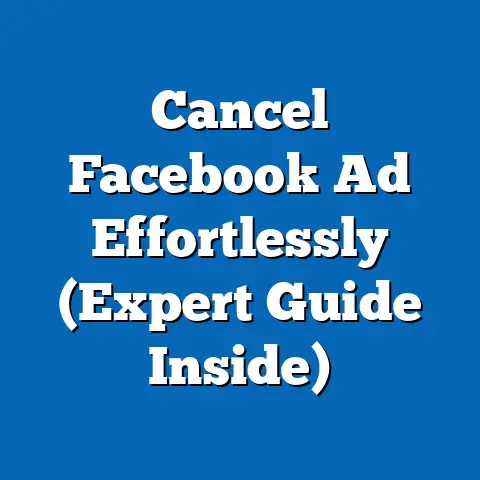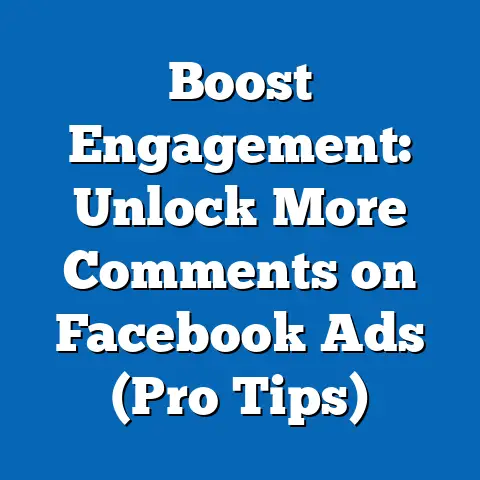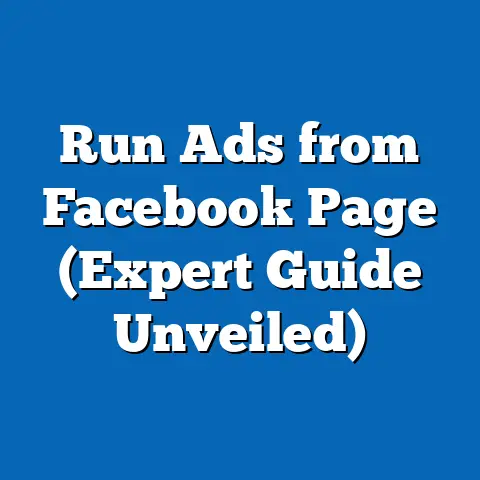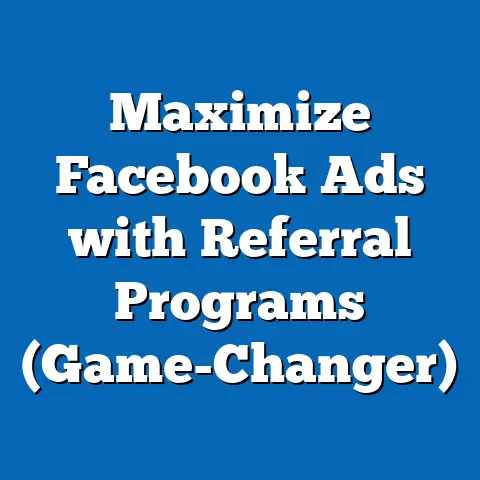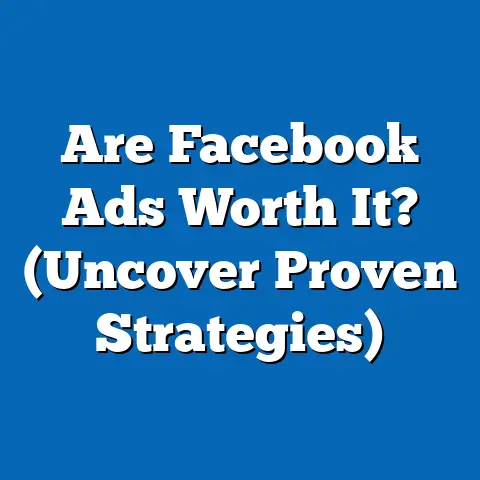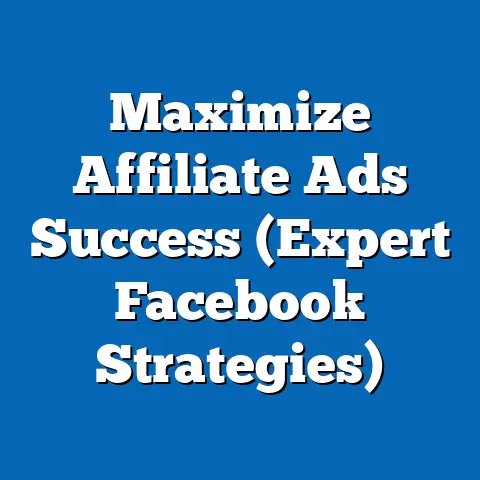Unlocking Ideal CTR for Facebook Ads (Essential Insights)
Facebook advertising can feel like navigating a complex maze. I remember when I first started, I was throwing money at the platform, hoping something would stick. I was so focused on getting my ads seen that I completely neglected whether they were actually compelling anyone to click. It was a costly mistake, and one that many new advertisers make. That’s where Click-Through Rate, or CTR, comes in.
In the world of Facebook Ads, CTR is a vital sign. It tells you whether your ad is resonating with your target audience, whether your messaging is on point, and ultimately, whether your campaigns are working. Think of it as the heartbeat of your ad’s performance. A healthy heartbeat means your ad is alive and kicking, driving traffic and conversions. A weak heartbeat? Well, it’s time for some serious diagnostics and adjustments.
But what exactly is CTR? Simply put, it’s the percentage of people who see your ad and actually click on it. It’s calculated by dividing the total number of clicks your ad receives by the total number of times it’s shown (impressions), and then multiplying by 100. A higher CTR generally indicates that your ad is relevant, engaging, and persuasive to your target audience.
Why is understanding CTR so crucial in the Facebook advertising ecosystem? Because it’s more than just a number. It’s a window into the effectiveness of your entire campaign. A good CTR can lead to lower ad costs, improved ad relevance scores, and ultimately, more conversions. A poor CTR, on the other hand, can signal that your targeting is off, your creative is weak, or your offer isn’t compelling enough.
Understanding Facebook Ads and CTR
To truly master CTR, you need to understand the underlying mechanics of Facebook advertising. It’s not just about throwing up a pretty picture and hoping for the best. It’s about understanding the platform, its algorithms, and how your ads interact with your target audience.
First, let’s break down the structure of Facebook ads. At their core, Facebook ads consist of three main elements:
- Formats: Facebook offers a variety of ad formats, each designed for different objectives and placements. These include single image ads, video ads, carousel ads (multiple images or videos), collection ads (ideal for e-commerce), and instant experiences (full-screen, immersive ads).
- Placements: Where your ad appears on Facebook (and the broader Meta network, including Instagram) is crucial. Common placements include the Facebook News Feed, Instagram Feed, Stories, Messenger, and Audience Network (third-party apps and websites).
- Targeting: This is where the magic happens. Facebook allows you to target your ads based on a wide range of criteria, including demographics (age, gender, location), interests, behaviors, connections, and custom audiences (based on your existing customer data).
Now, let’s talk about how Facebook determines ad visibility. It’s not simply a matter of who’s willing to pay the most. Facebook uses a complex algorithm, often referred to as the “ad auction,” to determine which ads to show to which users. This algorithm takes into account several factors, including:
- Bid: How much you’re willing to pay for a click or impression.
- Estimated Action Rates: Facebook’s prediction of how likely a user is to engage with your ad (e.g., click, like, comment, share). This is heavily influenced by your ad’s past performance and its relevance to the user.
- Ad Quality & Relevance: Facebook’s assessment of the quality and relevance of your ad to the user. This is based on factors like ad copy, visuals, landing page experience, and user feedback.
CTR plays a significant role in this ad auction. A high CTR signals to Facebook that your ad is relevant and engaging, which can lead to lower ad costs and increased visibility. Conversely, a low CTR can indicate that your ad is not resonating with your target audience, which can result in higher ad costs and decreased visibility.
But what’s considered a “good” CTR on Facebook? The answer, as with many things in digital marketing, is: it depends. Average CTR benchmarks vary significantly across different industries. For example, an e-commerce business might expect a lower CTR than a B2B company offering a highly specialized service.
While specific numbers can fluctuate, here are some general guidelines for average CTR benchmarks on Facebook:
- Average CTR Across All Industries: Around 0.9%
- Industries with Higher CTRs (e.g., Retail, Apparel): Can reach 1.5% or higher
- Industries with Lower CTRs (e.g., Finance, Insurance): May be closer to 0.7% or lower
Keep in mind that these are just averages. Your ideal CTR will depend on your specific business, target audience, and campaign objectives.
Finally, it’s crucial to understand the relationship between CTR and other key performance indicators (KPIs). CTR doesn’t exist in a vacuum. It’s interconnected with other metrics like conversion rate (the percentage of users who take a desired action after clicking on your ad), cost-per-click (CPC), and return on ad spend (ROAS).
A high CTR might seem like a good thing, but if your conversion rate is low, it means you’re attracting clicks but not turning them into customers. In this case, you need to focus on optimizing your landing page experience and making sure your offer is compelling.
Similarly, a low CPC might seem desirable, but if your CTR is also low, it means you’re not getting enough visibility for your ad. In this scenario, you need to focus on improving your ad creative and targeting to attract more clicks.
Takeaway: Understanding the mechanics of Facebook advertising, average CTR benchmarks in your industry, and the relationship between CTR and other KPIs is essential for creating successful campaigns. Don’t just focus on getting clicks; focus on getting the right clicks that lead to conversions and ultimately, business growth.
Key Factors Influencing CTR
Now that we’ve established the importance of CTR, let’s dive into the key factors that influence it. Think of these as the levers you can pull to optimize your ads and drive more clicks.
Ad Creativity
This is arguably the most important factor influencing CTR. Your ad creative – the visuals, copy, and call-to-action (CTA) – is what grabs the user’s attention and persuades them to click.
-
Visuals: In a visually-driven platform like Facebook, your visuals are your first impression. They need to be eye-catching, relevant, and high-quality. Use images or videos that resonate with your target audience and clearly communicate your message.
- Example: A clothing retailer might use a high-resolution image of a model wearing their latest collection, while a software company might use a short video demonstrating the key features of their product.
-
Copy: Your ad copy should be concise, compelling, and benefit-driven. Highlight the value proposition of your product or service and tell the user what they’ll gain by clicking on your ad.
-
Example: Instead of saying “We sell shoes,” say “Get 20% off stylish, comfortable shoes that will turn heads.”
-
Call-to-Action (CTA): Your CTA is the final nudge that encourages the user to click. Use strong, action-oriented language that tells the user exactly what you want them to do.
-
Examples: “Shop Now,” “Learn More,” “Sign Up,” “Get Started,” “Download Now.”
Visuals: In a visually-driven platform like Facebook, your visuals are your first impression. They need to be eye-catching, relevant, and high-quality. Use images or videos that resonate with your target audience and clearly communicate your message.
- Example: A clothing retailer might use a high-resolution image of a model wearing their latest collection, while a software company might use a short video demonstrating the key features of their product.
-
Copy: Your ad copy should be concise, compelling, and benefit-driven. Highlight the value proposition of your product or service and tell the user what they’ll gain by clicking on your ad.
-
Example: Instead of saying “We sell shoes,” say “Get 20% off stylish, comfortable shoes that will turn heads.”
-
Call-to-Action (CTA): Your CTA is the final nudge that encourages the user to click. Use strong, action-oriented language that tells the user exactly what you want them to do.
-
Examples: “Shop Now,” “Learn More,” “Sign Up,” “Get Started,” “Download Now.”
Copy: Your ad copy should be concise, compelling, and benefit-driven. Highlight the value proposition of your product or service and tell the user what they’ll gain by clicking on your ad.
Example: Instead of saying “We sell shoes,” say “Get 20% off stylish, comfortable shoes that will turn heads.”
Call-to-Action (CTA): Your CTA is the final nudge that encourages the user to click. Use strong, action-oriented language that tells the user exactly what you want them to do.
Examples: “Shop Now,” “Learn More,” “Sign Up,” “Get Started,” “Download Now.”
I’ve seen firsthand how a simple change in visuals or copy can dramatically impact CTR. Once, I was working with a client who was selling online courses. Their initial ads featured generic stock photos and bland copy. The CTR was abysmal – around 0.3%. We decided to revamp the creative, using authentic photos of real students and highlighting the tangible benefits of the course (e.g., career advancement, increased earning potential). The CTR jumped to over 2% almost overnight!
To understand what makes an ad effective, let’s break down a high-performing ad:
Imagine an ad for a meal kit delivery service. The ad features a vibrant, mouth-watering photo of a delicious meal, prepped and ready to cook. The copy reads: “Dinner in 30 Minutes? Yes, Please! Get fresh, pre-portioned ingredients and easy-to-follow recipes delivered to your door. Try [Meal Kit Service Name] today and get 50% off your first box! Shop Now.”
What makes this ad effective?
- Visual: The high-quality photo immediately grabs attention and appeals to the user’s sense of taste.
- Copy: The copy highlights the key benefit – quick and easy dinners – and addresses a common pain point for busy people.
- CTA: “Shop Now” is a clear and direct call to action that encourages the user to take the next step.
Audience Targeting
Even the most creative ad will fall flat if it’s shown to the wrong people. Precise audience targeting is crucial for enhancing CTR.
Facebook offers a wide range of targeting options, allowing you to reach specific demographics, interests, behaviors, and connections. The more targeted your audience, the more likely they are to find your ad relevant and click on it.
I’ve found that using Facebook’s audience insights tool is invaluable for identifying and segmenting target demographics. This tool provides detailed information about your target audience, including their interests, demographics, page likes, and purchase behavior.
Here are a few tips for effective audience targeting:
- Start with a broad audience: If you’re not sure who your ideal customer is, start with a broad audience based on general demographics and interests.
- Refine your audience based on data: As your campaigns run, analyze the data to see which segments are performing best. Refine your targeting based on this data to focus on the most responsive audiences.
- Use custom audiences: Upload your existing customer data (e.g., email lists, phone numbers) to create custom audiences. You can then target these customers directly or create lookalike audiences based on their characteristics.
Ad Placement
Where your ad appears on Facebook can also significantly impact CTR. Different placements have different engagement rates. For example, ads in the Facebook News Feed tend to have higher CTRs than ads in the right column.
Here’s a breakdown of common ad placements and their impact on CTR:
- Facebook News Feed: This is the most popular placement and generally has the highest CTR. Users are actively scrolling through their feed and are more likely to notice and engage with your ads.
- Instagram Feed: Similar to the Facebook News Feed, this placement offers high visibility and engagement potential, especially for visually appealing ads.
- Facebook Stories & Instagram Stories: These placements are ideal for short, engaging videos or images. Stories ads tend to have lower CTRs than feed ads, but they can still be effective for building brand awareness.
- Facebook Right Column: This placement is less prominent and generally has lower CTRs. It’s best suited for retargeting campaigns or ads with a clear and compelling offer.
- Audience Network: This placement allows you to extend your reach beyond Facebook and Instagram to third-party apps and websites. CTRs on the Audience Network can vary widely depending on the quality of the app or website.
Takeaway: Don’t underestimate the power of ad placement. Experiment with different placements to see which ones perform best for your specific ads and target audience. Use Facebook’s automatic placements feature to let the algorithm optimize your ad delivery across different placements, or manually select placements based on your campaign objectives and data insights.
Crafting High-CTR Ads
Now that you understand the key factors influencing CTR, let’s get practical. How do you actually create ads that resonate with your audience and drive more clicks? Here’s a step-by-step guide:
- Know Your Audience: Before you start writing copy or designing visuals, take the time to understand your target audience. What are their pain points, desires, and motivations? What kind of language do they use? What kind of visuals appeal to them? The more you know about your audience, the better you’ll be able to create ads that resonate with them.
-
Craft Compelling Headlines: Your headline is the first thing people see, so it needs to grab their attention and pique their interest. Use strong, benefit-driven language that tells the user what they’ll gain by clicking on your ad.
- Tips for Writing Compelling Headlines:
- Use numbers and statistics: “5 Ways to Boost Your Productivity”
- Ask a question: “Are You Ready to Achieve Your Dream Body?”
- Highlight a benefit: “Get Instant Access to Our Exclusive Content”
- Create a sense of urgency: “Limited Time Offer: Ends Tonight!”
-
Select Engaging Visuals: Your visuals should be eye-catching, relevant, and high-quality. Use images or videos that tell a story and evoke emotion.
-
Tips for Selecting Engaging Visuals:
- Use high-resolution images or videos: Avoid blurry or pixelated visuals.
- Showcase your product or service in action: Demonstrate how your product or service solves a problem or fulfills a need.
- Use authentic photos or videos: Avoid generic stock photos that look staged or unnatural.
- A/B test different visuals: Experiment with different images or videos to see which ones perform best.
-
Write Persuasive Copy: Your ad copy should be concise, compelling, and benefit-driven. Highlight the value proposition of your product or service and tell the user what they’ll gain by clicking on your ad.
-
Tips for Writing Persuasive Copy:
- Focus on the benefits, not the features: Instead of saying “Our product has feature X,” say “Our product will help you achieve Y.”
- Use strong, action-oriented language: “Get Started Today,” “Learn More Now,” “Download Your Free Guide.”
- Create a sense of scarcity or urgency: “Limited Time Offer,” “While Supplies Last,” “Don’t Miss Out!”
- Address potential objections: “Worried about X? Our product solves that problem.”
-
Utilize Strong CTAs: Your CTA should be clear, direct, and action-oriented. Tell the user exactly what you want them to do.
-
Examples of Strong CTAs:
- Shop Now: Ideal for e-commerce businesses.
- Learn More: Great for informational ads or ads that require more explanation.
- Sign Up: Perfect for building your email list or generating leads.
- Get Started: Effective for software companies or service providers.
- Download Now: Useful for offering free content or resources.
- Tips for Writing Compelling Headlines:
Craft Compelling Headlines: Your headline is the first thing people see, so it needs to grab their attention and pique their interest. Use strong, benefit-driven language that tells the user what they’ll gain by clicking on your ad.
- Tips for Writing Compelling Headlines:
- Use numbers and statistics: “5 Ways to Boost Your Productivity”
- Ask a question: “Are You Ready to Achieve Your Dream Body?”
- Highlight a benefit: “Get Instant Access to Our Exclusive Content”
- Create a sense of urgency: “Limited Time Offer: Ends Tonight!”
-
Select Engaging Visuals: Your visuals should be eye-catching, relevant, and high-quality. Use images or videos that tell a story and evoke emotion.
-
Tips for Selecting Engaging Visuals:
- Use high-resolution images or videos: Avoid blurry or pixelated visuals.
- Showcase your product or service in action: Demonstrate how your product or service solves a problem or fulfills a need.
- Use authentic photos or videos: Avoid generic stock photos that look staged or unnatural.
- A/B test different visuals: Experiment with different images or videos to see which ones perform best.
-
Write Persuasive Copy: Your ad copy should be concise, compelling, and benefit-driven. Highlight the value proposition of your product or service and tell the user what they’ll gain by clicking on your ad.
-
Tips for Writing Persuasive Copy:
- Focus on the benefits, not the features: Instead of saying “Our product has feature X,” say “Our product will help you achieve Y.”
- Use strong, action-oriented language: “Get Started Today,” “Learn More Now,” “Download Your Free Guide.”
- Create a sense of scarcity or urgency: “Limited Time Offer,” “While Supplies Last,” “Don’t Miss Out!”
- Address potential objections: “Worried about X? Our product solves that problem.”
-
Utilize Strong CTAs: Your CTA should be clear, direct, and action-oriented. Tell the user exactly what you want them to do.
-
Examples of Strong CTAs:
- Shop Now: Ideal for e-commerce businesses.
- Learn More: Great for informational ads or ads that require more explanation.
- Sign Up: Perfect for building your email list or generating leads.
- Get Started: Effective for software companies or service providers.
- Download Now: Useful for offering free content or resources.
- Use numbers and statistics: “5 Ways to Boost Your Productivity”
- Ask a question: “Are You Ready to Achieve Your Dream Body?”
- Highlight a benefit: “Get Instant Access to Our Exclusive Content”
- Create a sense of urgency: “Limited Time Offer: Ends Tonight!”
Select Engaging Visuals: Your visuals should be eye-catching, relevant, and high-quality. Use images or videos that tell a story and evoke emotion.
Tips for Selecting Engaging Visuals:
- Use high-resolution images or videos: Avoid blurry or pixelated visuals.
- Showcase your product or service in action: Demonstrate how your product or service solves a problem or fulfills a need.
- Use authentic photos or videos: Avoid generic stock photos that look staged or unnatural.
- A/B test different visuals: Experiment with different images or videos to see which ones perform best.
Write Persuasive Copy: Your ad copy should be concise, compelling, and benefit-driven. Highlight the value proposition of your product or service and tell the user what they’ll gain by clicking on your ad.
Tips for Writing Persuasive Copy:
- Focus on the benefits, not the features: Instead of saying “Our product has feature X,” say “Our product will help you achieve Y.”
- Use strong, action-oriented language: “Get Started Today,” “Learn More Now,” “Download Your Free Guide.”
- Create a sense of scarcity or urgency: “Limited Time Offer,” “While Supplies Last,” “Don’t Miss Out!”
- Address potential objections: “Worried about X? Our product solves that problem.”
Utilize Strong CTAs: Your CTA should be clear, direct, and action-oriented. Tell the user exactly what you want them to do.
Examples of Strong CTAs:
- Shop Now: Ideal for e-commerce businesses.
- Learn More: Great for informational ads or ads that require more explanation.
- Sign Up: Perfect for building your email list or generating leads.
- Get Started: Effective for software companies or service providers.
- Download Now: Useful for offering free content or resources.
Takeaway: Crafting high-CTR ads is a combination of art and science. It requires understanding your audience, creating compelling creative, and using strong CTAs. Don’t be afraid to experiment and test different approaches to see what works best for your specific business.
Testing and Analyzing Ad Performance
Creating a great ad is only half the battle. You also need to test and analyze its performance to see what’s working and what’s not. This is where A/B testing comes in.
A/B testing involves creating two or more versions of your ad with slight variations (e.g., different headlines, visuals, CTAs) and then running them simultaneously to see which one performs better. This allows you to identify the most effective elements of your ad and optimize it for maximum CTR.
Here’s a step-by-step guide to setting up A/B tests for your Facebook ads:
- Identify the element you want to test: Start by choosing one element of your ad to test, such as the headline, visual, or CTA.
- Create two or more variations of your ad: Create two or more versions of your ad with slight variations in the element you’re testing. For example, you might create two versions of your ad with different headlines.
- Set up your A/B test in Facebook Ads Manager: Facebook Ads Manager has a built-in A/B testing feature that allows you to easily create and manage your tests.
- Run your A/B test for a sufficient period: Run your A/B test for at least a week or two to gather enough data to make a statistically significant conclusion.
- Analyze the results and choose the winning ad: Once your A/B test is complete, analyze the results to see which version of your ad performed better. Choose the winning ad and use it as your control for future tests.
I always recommend focusing on one element at a time when A/B testing. This allows you to isolate the impact of each change and accurately determine what’s driving the results. If you change too many elements at once, it’s difficult to know which change is responsible for the improvement (or decline) in performance.
Here are some tools and metrics for analyzing ad performance and understanding CTR data:
- Facebook Ads Manager: This is your primary tool for tracking and analyzing your ad performance. It provides detailed data on impressions, clicks, CTR, CPC, conversion rate, and ROAS.
- Google Analytics: This tool allows you to track user behavior on your website after they click on your ad. It can help you understand how your ads are contributing to your overall business goals.
- Heatmaps and User Recordings: These tools allow you to see how users are interacting with your landing page after they click on your ad. They can help you identify areas for improvement and optimize your landing page for higher conversion rates.
Let’s look at a real-world example of a successful A/B test that led to improved CTR.
A client of mine, a local restaurant, was running Facebook ads to promote their lunch specials. Their initial ads featured a generic image of a hamburger and the headline “Best Burgers in Town.” The CTR was around 0.5%.
We decided to run an A/B test with two different headlines:
- Headline A: “Best Burgers in Town” (Control)
- Headline B: “Lunch Special: Gourmet Burger + Fries + Drink for $12” (Variation)
The results were dramatic. Headline B, which highlighted the specific lunch special and price, increased CTR by over 200%! This simple change in headline resulted in significantly more clicks and ultimately, more customers for the restaurant.
Takeaway: A/B testing is essential for optimizing your ads for better CTR. Don’t just guess what works; test it! Use data to inform your decisions and continuously improve your ad performance.
Ongoing Optimization Strategies
Facebook advertising is not a “set it and forget it” strategy. It requires continuous monitoring and optimization to ensure long-term success. The platform is constantly evolving, with new features, algorithm changes, and shifting user behaviors. To stay ahead of the curve, you need to adopt a mindset of continuous improvement.
Here are some strategies for monitoring ad performance and making data-driven adjustments:
- Set up regular reporting: Schedule regular reports to track your key metrics, including impressions, clicks, CTR, CPC, conversion rate, and ROAS. This will allow you to identify trends and potential problems early on.
- Monitor your ad relevance score: Facebook’s ad relevance score is a measure of how relevant your ad is to your target audience. A higher relevance score can lead to lower ad costs and increased visibility. Monitor your relevance score and make adjustments to your ad creative or targeting if it’s low.
- Pay attention to user feedback: Monitor comments and reviews on your ads to see what users are saying about your product or service. This can provide valuable insights into how to improve your ads and your overall business.
- Stay updated with Facebook’s algorithm changes: Facebook is constantly tweaking its algorithm, which can impact your ad performance. Stay updated with the latest changes and adjust your strategies accordingly.
- Experiment with new features and ad formats: Facebook is always rolling out new features and ad formats. Experiment with these new options to see if they can improve your ad performance.
- Analyze your competitors’ ads: Use Facebook’s Ad Library to see what your competitors are doing. This can give you ideas for your own ads and help you identify opportunities to differentiate yourself.
I’ve learned that the most successful Facebook advertisers are the ones who are constantly learning and adapting. They’re not afraid to try new things, and they’re always looking for ways to improve their performance.
Takeaway: Continuous optimization is essential for long-term success in Facebook advertising. Monitor your ad performance, stay updated with platform changes, and experiment with new features and strategies to stay ahead of the curve.
Conclusion
Unlocking your ideal CTR for Facebook ads is an ongoing process that requires a combination of creativity, data analysis, and continuous optimization. By understanding the key factors that influence CTR, crafting compelling ads, testing and analyzing their performance, and implementing ongoing optimization strategies, you can significantly improve your ad performance and achieve your business goals.
Remember, CTR is more than just a number. It’s a reflection of how well your ads resonate with your target audience. By focusing on creating relevant, engaging, and persuasive ads, you can drive more clicks, lower your ad costs, and ultimately, grow your business.
I encourage you to implement the strategies discussed in this article and track your results. Don’t be afraid to experiment and test different approaches to see what works best for your specific business.
Call to Action
I’d love to hear about your experiences with Facebook ads. What strategies have you found to be most effective for improving CTR? Share your insights and results in the comments section below!
And if you’re looking for more insights on Facebook advertising and digital marketing trends, be sure to subscribe to my newsletter. I’ll share my latest tips, strategies, and case studies to help you stay ahead of the curve.

